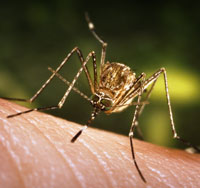St. Louis encephalitis pathophysiology
|
St. Louis encephalitis Microchapters |
|
Diagnosis |
|---|
|
Treatment |
|
Case Studies |
|
St. Louis encephalitis pathophysiology On the Web |
|
American Roentgen Ray Society Images of St. Louis encephalitis pathophysiology |
|
Risk calculators and risk factors for St. Louis encephalitis pathophysiology |
Editor-In-Chief: C. Michael Gibson, M.S., M.D. [1] Associate Editor(s)-in-Chief: : Vishnu Vardhan Serla M.B.B.S. [2]
Pathophysiology

St. Louis encephalitis virus is transmitted to humans through the bite of an infected mosquito. All residents of and visitors to areas where virus activity has been identified are at risk of getting St. Louis encephalitis, particularly persons living in crowded, low-income areas, and those who engage in outdoor work and recreational activities. St. Louis encephalitis virus infection is thought to confer life-long immunity against re-infection with St. Louis encephalitis virus.
During the summer season, St. Louis encephalitis virus is maintained in a mosquito-bird-mosquito cycle, with periodic amplification by peridomestic birds and Culex species mosquitoes. In Florida, the principal vector is Culex nigripalpus, in the Midwest, Culex pipiens and Culex quinquefasciatus and in the western United States, Culex tarsalis and members of the Culex pipiens complex. Humans and domestic mammals can acquire SLEV infection, but are dead-end hosts.

What is the basic St. Louis encephalitis virus transmission cycle?
Mosquitoes (primarily the Culex species) become infected by feeding on birds infected with the St. Louis encephalitis virus. Infected mosquitoes then transmit the St. Louis encephalitis virus to humans and animals during the feeding process. The St. Louis encephalitis virus grows both in the infected mosquito and the infected bird, but does not make either one sick.
What is the incubation period for St. Louis encephalitis?
The incubation period (time from infection to illness) is usually five to 15 days.
External Link
http://www.cdc.gov/sle/index.html